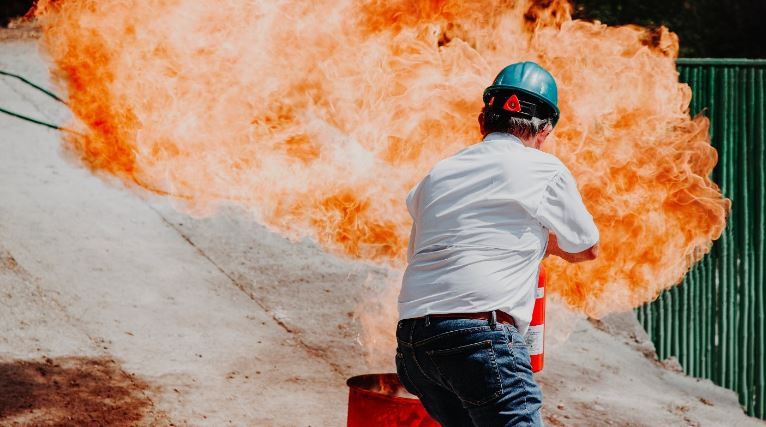
Fire Prevention
Fire safety training is vital because, at its core, it encourages the prevention of fires. Effective training assists employees in identifying potential risks and hazards to watch for. When occupants know how to recognize fire hazards and make changes or adjustments, they can reduce the chance of a fire happening in the first place.
Proper Response
Building occupants are the first line of emergency fire response. With proper training, they can act as an early part of the emergency response team and fill the gap between when a fire crew is called and when they arrive. Additionally, fire safety training prepares building occupants for a safe response if a fire does start, allowing them to act quickly and appropriately to extinguish or slow the spread and to evacuate safely. They will understand evacuation plans and procedures and how to use fire extinguishers properly if needed.
Training Requirements
Many regulatory agencies, such as the Occupational Safety and Health Administration (OSHA), require fire safety training. These requirements may vary by location, industry, or unique hazards, so a fire protection consultant should be involved in developing all fire safety training, as fire protection experts understand the requirements and how to tailor training per client.
OSHA
The Occupational Safety and Health Administration has workplace fire safety requirements. These requirements are outlined in various OSHA standards, including:
- General Industry Standards (29 CFR 1910): OSHA’s general industry standards contain provisions related to fire safety, including requirements for exit routes, fire prevention plans, fire detection systems, fire extinguishers, and emergency action plans.
- Portable Fire Extinguishers (29 CFR 1910.157): This standard applies to the placement, use, maintenance, and testing of portable fire extinguishers provided for employees’ use.
- Construction Industry Standards (29 CFR 1926): OSHA’s construction industry standards include provisions related to fire protection and prevention, such as requirements for fire extinguishers, temporary heating devices, and fire protection equipment.
- Hazardous Waste Operations and Emergency Response Standard (29 CFR 1910.120): This standard includes requirements for emergency response procedures, including those related to fire emergencies, for employees involved in hazardous waste operations.
- Process Safety Management (PSM) Standard (29 CFR 1910.119): The PSM standard outlines requirements for managing processes involving highly hazardous chemicals, including fire prevention and protection provisions.
- Fire Brigades (29 CFR 1910.156): OSHA’s fire brigade standard contains requirements for the organization, training, and operation of workplace fire brigades.
The above standards are only some of the many OSHA standards that address fire safety in the workplace. Employers are responsible for complying with relevant OSHA standards and ensuring the safety of their employees regarding fire hazards. Typically, this involves implementing measures for fire prevention, providing fire safety training to employees, maintaining fire detection and suppression systems, and developing emergency response plans.
Government
The federal government has additional rules and regulations on fire prevention and safety training in the workplace, and this is also frequently the case with local government locations, educational facilities, hospitals, and private businesses.
Industry-specific
General fire safety training will remain the same in many aspects, but site-specific training is often required because industries can vary greatly. For example, the hazards in a single-story building will differ from those in a multi-story building. Fire training developers must also consider the type of occupancy. Hazards in a retail store or office building may not be the same as an industrial plant or hospital, and some locations may be open to the public while others are private.
With so many possible considerations, organizations must carefully assess their specific fire safety training needs based on the type of industry and its inherent hazards and tailor training accordingly.
Ultimately, the goal remains the same: ensure compliance with existing fire safety regulations and meet requirements for specific industries to achieve a safe and prepared workplace that will protect the lives of employees and occupants, protect property, and minimize losses when emergencies occur.
Fire Safety Training Components
Every fire safety training course must, at minimum, include the following components: fire basics, proper use of fire extinguishers, and an evacuation plan.
Fire Basics
The fundamentals of fire safety training start with a basic understanding of fire, which includes the “fire tetrahedron.” The fire tetrahedron is a visual depicting the concept of fire and the four elements it needs to start and continue. A fire needs heat, fuel, and oxygen to start and continue a chemical chain reaction. If one or more of these elements is removed, a fire cannot continue to burn.
Another component of fires that should be a part of fire safety training is the five classes of fires, which include:
Source: NFPA
Lastly, basic fire safety training should include how to recognize and prevent fire hazards. These hazards will vary depending on the facility type and other factors. However, common hazards include misusing or damaging electrical equipment, improperly storing flammable liquids, smoking in non-designated areas, etc.
Proper Use of Fire Extinguishers
Once trainees understand how a fire can ignite and the different types of fires, training on using the appropriate fire extinguisher is essential. The purpose of fire extinguishers is to interrupt the chain reaction. There are several types of extinguishers that put fires out in different ways, depending on the class(es) of fire; each extinguisher works to deactivate one of the legs of the fire tetrahedron. Some fire extinguishers are designed for multiple fire classifications; these will be marked with the letters of the corresponding fire classes they are designed for, such as A-B-C extinguishers.
Training should include understanding the types and ratings of extinguishers and what class of fires they are appropriate for.
Types of extinguishers include:
- Carbon Dioxide
- Dry Chemical
- Dry Powder
- Film-forming Foam
- Halogenated Agent
- Water
- Wet Chemical
Evacuation Plan
Training employees on an evacuation plan is a critical aspect of workplace safety. Training on an evacuation plan should cover key elements, including exit routes, emergency meeting points, emergency equipment locations, and communication protocols.
Strategies for Delivering Effective Training
A fire safety training program should incorporate the following elements:
Clear Objectives
Define specific learning objectives for the training program, outlining what participants should know and be able to do after completing the training.
Tailored Content
Customize the training content to address the specific fire hazards, emergency procedures, and regulatory requirements relevant to the industry, operations, and work environment.
Variety of Delivery
Instruct using various methods, such as presentations, demonstrations, hands-on exercises, and interactive activities.
Expert Instructors
Instructors must be knowledgeable, experienced, and certified in fire safety principles and procedures to convey accurate information and answer participants’ questions.
Hands-on Training
Hands-on training for fire extinguishers and other emergency equipment is essential for proper use. Participants need to practice and demonstrate fire safety skills in a controlled environment. Regularly practicing evacuation procedures is also vital so occupants can easily recall that information in an emergency.
Up-to-date Content
Training facilitators must often adjust training material to include new regulations, fire code requirements, and other relevant information. Changes in the workplace may also require adjustments to training to ensure new hazards within the workplace, building design, or a change of occupancy are addressed.
Telgian Engineering & Consulting Services
Telgian Engineering & Consulting offers fire safety and evacuation training services. Our training will include all the topics mentioned in this article, as well as information specific to each client.
Training Development and Format
TEC will work closely with the client to understand their concerns, hazards, and facility layouts and ensure that all our training is relevant to their employees and building occupants.
TEC offers this training in various formats, including:
- Lecture and demonstrations (in-person or live webinar)
- Hands-on practice with fire and life safety equipment
- Building(s) walkthroughs
Emergency Plan Development
TEC offers emergency plan development services, which includes:
- Risk assessment of the site to identify and address the client’s unique risks
- Code and regulation consulting to achieve compliance with local, state, and federal requirements
- Effective evacuation procedure development specific to the client’s needs, facility layout, and type of occupancy
- Consideration of building occupants’ ability to evacuate and access the need for any special equipment or training to assist those who may be unable to evacuate, for example, elderly, pediatric, injured/disabled, or other limitations
Benefits of Fire Safety Training

Questions? Please contact Chad Green at chgreen@telgian.com or 480-698-7951.
About Telgian Engineering & Consulting, LLC
Leading the industry since 1985, TEC is a full-service global engineering and risk mitigation consulting firm specializing in complex, multi-discipline public and private sector projects. TEC provides professional services related to the protection of people, property, information, and organizational mission against preventable losses. Solutions include strategic/enterprise risk management, fire protection engineering, industrial security, environmental health and safety, emergency management, operations continuity consulting, and construction administration services. TEC professionals are dedicated to delivering value through effective protection solutions that meet today’s unique risk challenges. Contact us for immediate support at 1.302.300.1400 or tec@telgian.com.


